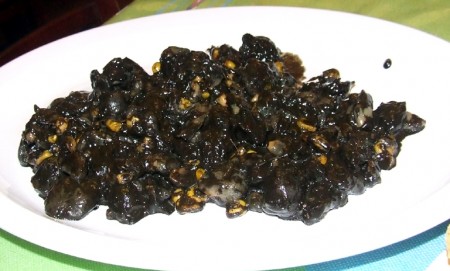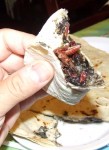Huitlacoche (corn smut)
Mexico
It raises a few eyebrows when I announce that I’m headed to Los Angeles’ Koreatown to check out the smut, but in this particular case it’s corn smut (huitlacoche) I’m referring to. Huitlacoche has been a staple of the Central American diet for centuries – it is essentially a fungus that infects the corn kernels, swelling them and turning them black with spores. Where American farmers would historically destroy their infected crop, Mexican growers have intentionally introduced the fungus into theirs. Huitlacoche fetches a higher market price than the healthy corn would; in the past decade, some American corn growers have added it to their crop, but it is still somewhat slow to catch on. There is some debate on the origin and meaning of the word, “huitlacoche” – the word is derived from the Nahuatl language, and there are some who roughly translate this to “raven excrement”, although the actual meaning and source are still up for discussion. Not having encountered raven excrement, I can’t attest to the accuracy of the description, and certainly not the taste. To my eyes, it has the appearance of overcooked spinach in squid ink. Huitlacoche is immensely popular in the Mexican state of Oaxaca, and the definitive source for huitlacoche in Los Angeles is Guelaguetza Restaurante, a local chain specializing in Oaxacan cuisine. Owner Bricia Lopez graciously invited me to share the dish; I had eaten at Guelaguetza previously, which readers of this blog may remember from an article about their tasty preparation of chapulines (grasshoppers).
I eagerly anticipated digging in to the murky, black fungus, but started out with a tall glass of horchata (a Mexican rice drink). The horchata had crushed nuts on top and a pink hue that I had never seen before in other horchatas I’ve tried. Bricia told me that they puree tuña (the Spanish word for the pear, or fruit of the cactus, not Charlie from Sunkist), which gives the drink a fruity sweetness and a little color. She had the huitlacoche prepared two ways – in an empanada (essentially a giant folded-over tortilla filled with the fungus and gooey, melted Oaxacan string cheese), and cooked with onions and jalapeños for building tacos. I couldn’t resist sampling a forkful of the bare-naked fungus first; it had a rich, earthy taste like the ghost of a wood ear mushroom, with the distant remnant flavor of the host ear of corn. The onion and peppers added some spice and flavor, but didn’t diminish that woody, mushroom taste. I had a hard time deciding whether to dig into the empanada or construct a taco, so I followed her lead as she filled a tortilla with some of the huitlacoche and a generous batch of the chapulines that had been roasted with a little garlic, salt and lime. As off-putting as this image of the grasshoppers drowning in the inky black fungus may be to the uninitiated, I could barely contain myself, prepared for the wild combination of flavors and textures. The chapulines added a wonderful crispiness to the soft, moist huitlacoche and the lime they were cooked with added a citrusy zest. Figure in the bite from the jalapeños and the sweet flavor of the onions and you get a pretty good idea of the amazing sensory experience eating this dish was.
The empanada is probably a better choice for the entry-level corn smut consumer. Nothing shocking or crazy here – with the visual subdued by the surrounding tortilla, the diner simply encounters the mushroom/corn hybrid flavor of the huitlacoche and the melted mozzarella-like queso Oaxaca, resembling a damned fine quesadilla in appearance and taste. Be forewarned that the empanada is huge, so bring friends to help you eat it. Overall, both dishes were incredibly delicious, healthy and satisfying. This is another of those foods that make you scratch your head in wonder as to who decided this plant disease would be edible, but I’d like to build a flux capacitor so that I might go back in time and personally shake their hand and buy them a drink.
If you’re reading this at work and your boss asks what you’re doing, tell him you’re checking out smut online. After you get fired you can head down to Oaxaca and eat huitlacoche until your unemployment check runs out, or just visit Guelaguetza – I’ll even spring for a horchata.
Guelaguetza Restaurante
3014 W. Olympic Blvd.
Los Angeles, CA 90006
GPS coordinates: 37°52’11.25″N 122°18’1.83″W
Find Guelaguetza on facebook
Follow Guelaguetza on twitter





mmmmmhhhhhhhhhhhmmmmmmmmmm cornography!
Smut peddler!!
No, it was too far to take the bicycle, so I drove.